Economics: Analyzing Market Structures, Free Trade, and Labor Dynamics
VerifiedAdded on 2023/06/10
|7
|1135
|409
Homework Assignment
AI Summary
This economics assignment provides a detailed analysis of market structures, focusing on perfect and monopolistic competition with real-world examples. It examines the benefits of Australia's free trade agreements, highlighting GDP growth, increased household incomes, job creation, and reduced prices. The assignment also explores the positive influence of technology and innovation on the labor market, emphasizing skill acquisition, increased productivity, and the creation of new opportunities despite disruptive technological changes. The overall conclusion supports the idea that technology enhances the labor market by fostering new skills and opportunities for workers.
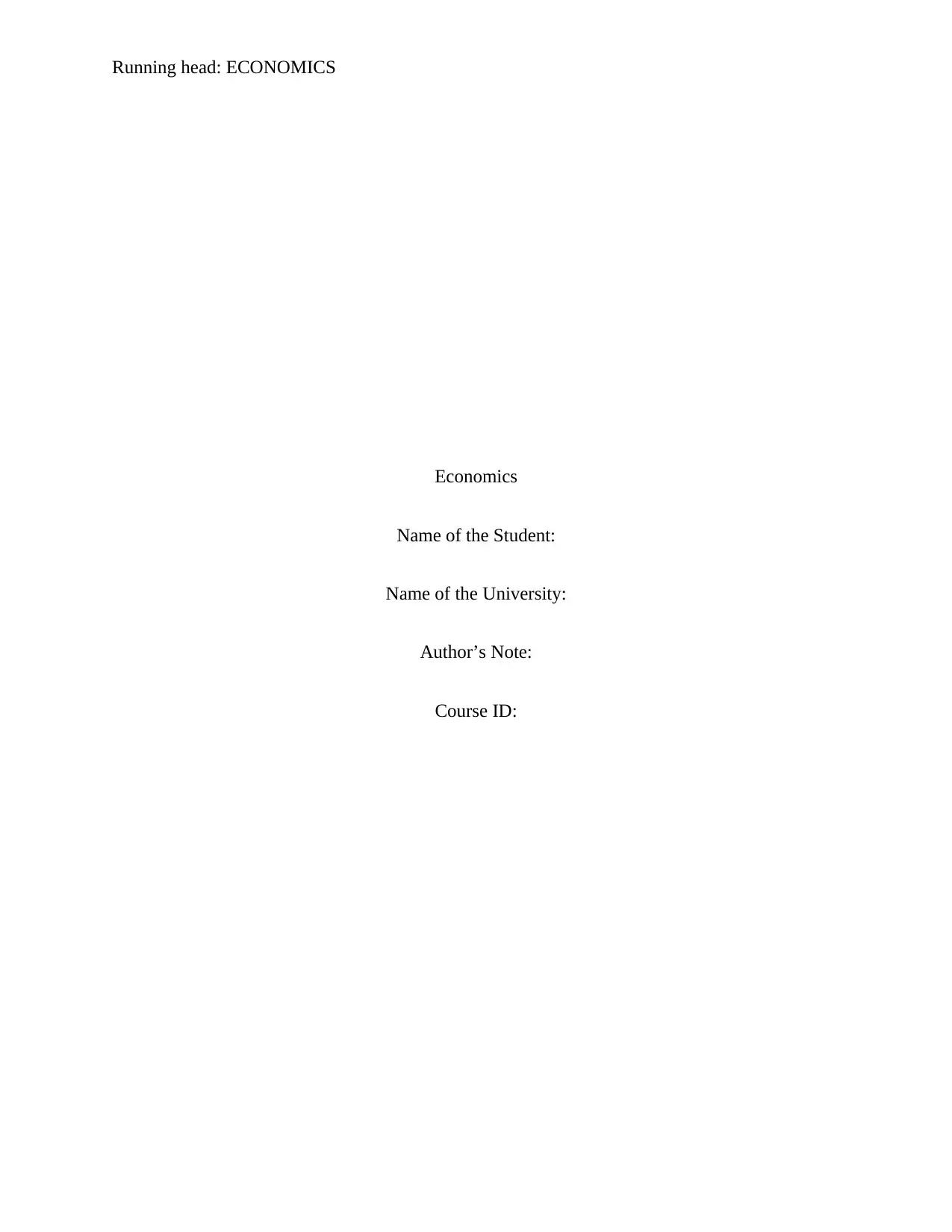
Running head: ECONOMICS
Economics
Name of the Student:
Name of the University:
Author’s Note:
Course ID:
Economics
Name of the Student:
Name of the University:
Author’s Note:
Course ID:
Paraphrase This Document
Need a fresh take? Get an instant paraphrase of this document with our AI Paraphraser
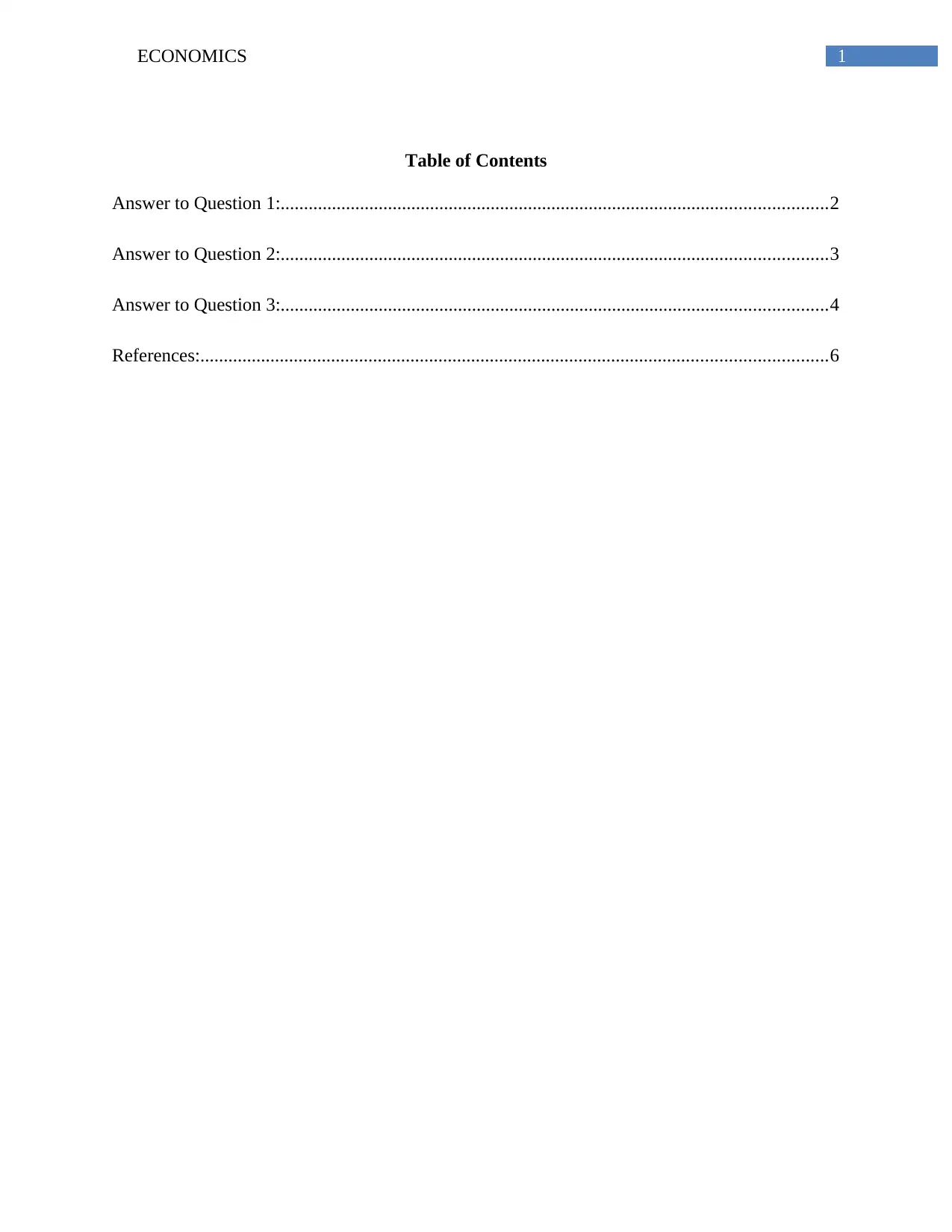
1ECONOMICS
Table of Contents
Answer to Question 1:.....................................................................................................................2
Answer to Question 2:.....................................................................................................................3
Answer to Question 3:.....................................................................................................................4
References:......................................................................................................................................6
Table of Contents
Answer to Question 1:.....................................................................................................................2
Answer to Question 2:.....................................................................................................................3
Answer to Question 3:.....................................................................................................................4
References:......................................................................................................................................6
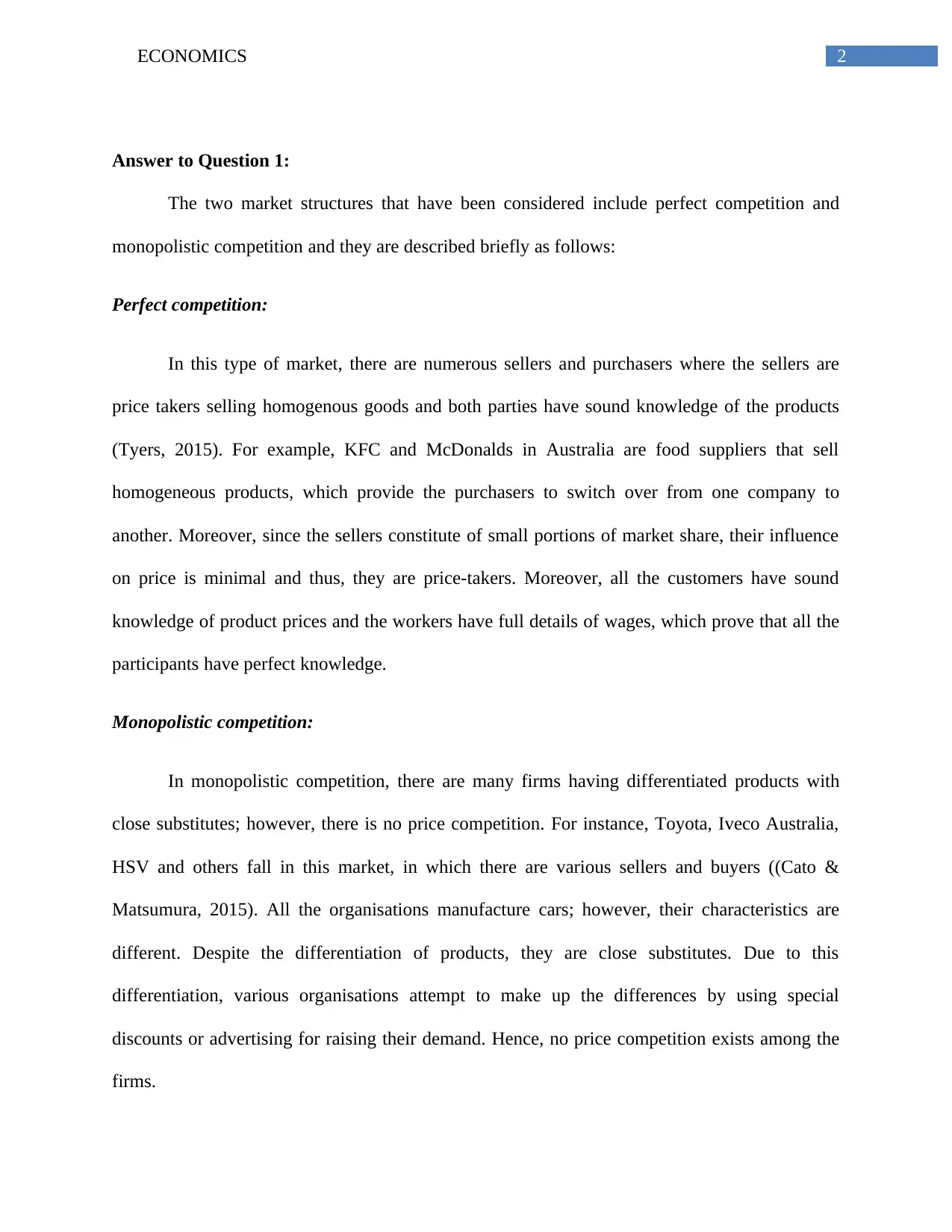
2ECONOMICS
Answer to Question 1:
The two market structures that have been considered include perfect competition and
monopolistic competition and they are described briefly as follows:
Perfect competition:
In this type of market, there are numerous sellers and purchasers where the sellers are
price takers selling homogenous goods and both parties have sound knowledge of the products
(Tyers, 2015). For example, KFC and McDonalds in Australia are food suppliers that sell
homogeneous products, which provide the purchasers to switch over from one company to
another. Moreover, since the sellers constitute of small portions of market share, their influence
on price is minimal and thus, they are price-takers. Moreover, all the customers have sound
knowledge of product prices and the workers have full details of wages, which prove that all the
participants have perfect knowledge.
Monopolistic competition:
In monopolistic competition, there are many firms having differentiated products with
close substitutes; however, there is no price competition. For instance, Toyota, Iveco Australia,
HSV and others fall in this market, in which there are various sellers and buyers ((Cato &
Matsumura, 2015). All the organisations manufacture cars; however, their characteristics are
different. Despite the differentiation of products, they are close substitutes. Due to this
differentiation, various organisations attempt to make up the differences by using special
discounts or advertising for raising their demand. Hence, no price competition exists among the
firms.
Answer to Question 1:
The two market structures that have been considered include perfect competition and
monopolistic competition and they are described briefly as follows:
Perfect competition:
In this type of market, there are numerous sellers and purchasers where the sellers are
price takers selling homogenous goods and both parties have sound knowledge of the products
(Tyers, 2015). For example, KFC and McDonalds in Australia are food suppliers that sell
homogeneous products, which provide the purchasers to switch over from one company to
another. Moreover, since the sellers constitute of small portions of market share, their influence
on price is minimal and thus, they are price-takers. Moreover, all the customers have sound
knowledge of product prices and the workers have full details of wages, which prove that all the
participants have perfect knowledge.
Monopolistic competition:
In monopolistic competition, there are many firms having differentiated products with
close substitutes; however, there is no price competition. For instance, Toyota, Iveco Australia,
HSV and others fall in this market, in which there are various sellers and buyers ((Cato &
Matsumura, 2015). All the organisations manufacture cars; however, their characteristics are
different. Despite the differentiation of products, they are close substitutes. Due to this
differentiation, various organisations attempt to make up the differences by using special
discounts or advertising for raising their demand. Hence, no price competition exists among the
firms.
⊘ This is a preview!⊘
Do you want full access?
Subscribe today to unlock all pages.

Trusted by 1+ million students worldwide
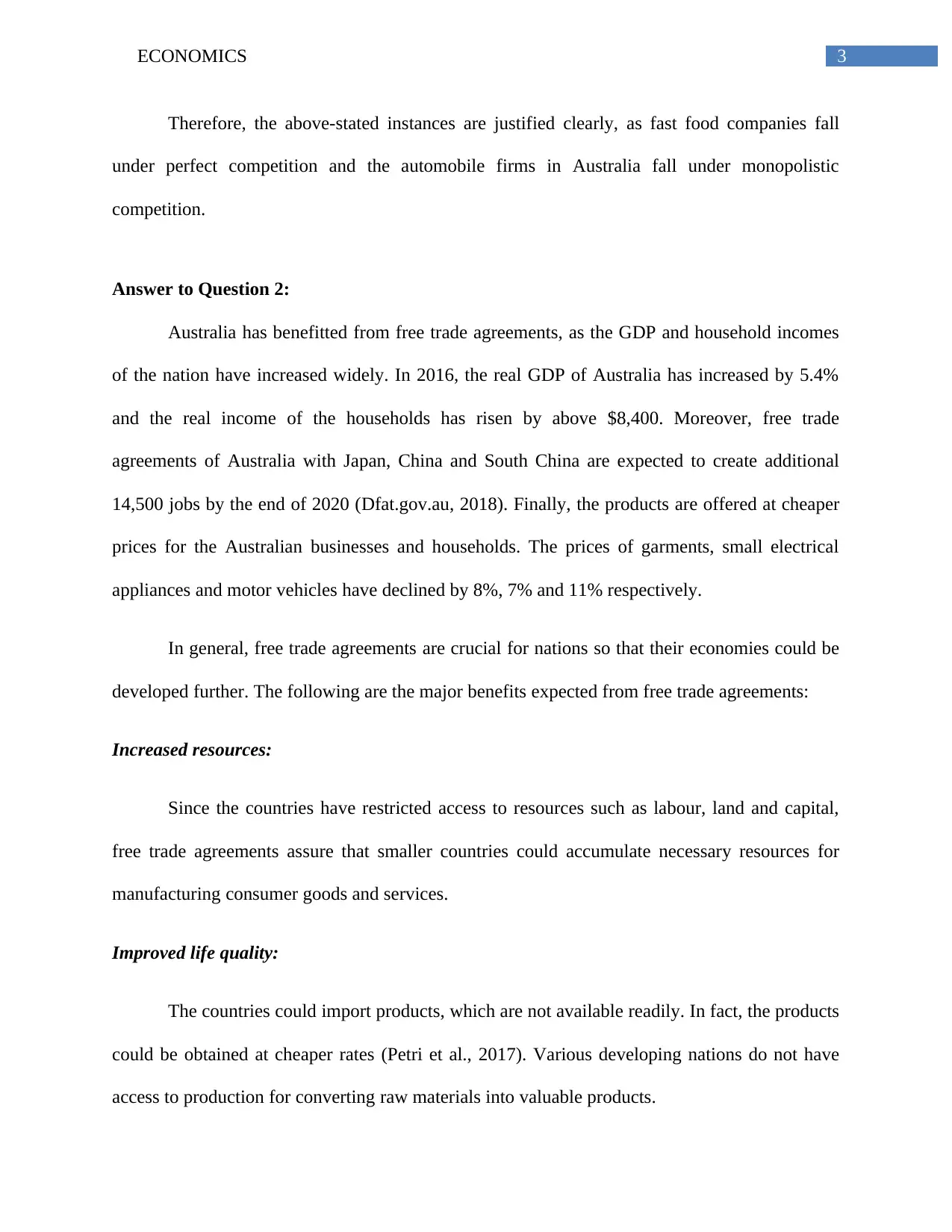
3ECONOMICS
Therefore, the above-stated instances are justified clearly, as fast food companies fall
under perfect competition and the automobile firms in Australia fall under monopolistic
competition.
Answer to Question 2:
Australia has benefitted from free trade agreements, as the GDP and household incomes
of the nation have increased widely. In 2016, the real GDP of Australia has increased by 5.4%
and the real income of the households has risen by above $8,400. Moreover, free trade
agreements of Australia with Japan, China and South China are expected to create additional
14,500 jobs by the end of 2020 (Dfat.gov.au, 2018). Finally, the products are offered at cheaper
prices for the Australian businesses and households. The prices of garments, small electrical
appliances and motor vehicles have declined by 8%, 7% and 11% respectively.
In general, free trade agreements are crucial for nations so that their economies could be
developed further. The following are the major benefits expected from free trade agreements:
Increased resources:
Since the countries have restricted access to resources such as labour, land and capital,
free trade agreements assure that smaller countries could accumulate necessary resources for
manufacturing consumer goods and services.
Improved life quality:
The countries could import products, which are not available readily. In fact, the products
could be obtained at cheaper rates (Petri et al., 2017). Various developing nations do not have
access to production for converting raw materials into valuable products.
Therefore, the above-stated instances are justified clearly, as fast food companies fall
under perfect competition and the automobile firms in Australia fall under monopolistic
competition.
Answer to Question 2:
Australia has benefitted from free trade agreements, as the GDP and household incomes
of the nation have increased widely. In 2016, the real GDP of Australia has increased by 5.4%
and the real income of the households has risen by above $8,400. Moreover, free trade
agreements of Australia with Japan, China and South China are expected to create additional
14,500 jobs by the end of 2020 (Dfat.gov.au, 2018). Finally, the products are offered at cheaper
prices for the Australian businesses and households. The prices of garments, small electrical
appliances and motor vehicles have declined by 8%, 7% and 11% respectively.
In general, free trade agreements are crucial for nations so that their economies could be
developed further. The following are the major benefits expected from free trade agreements:
Increased resources:
Since the countries have restricted access to resources such as labour, land and capital,
free trade agreements assure that smaller countries could accumulate necessary resources for
manufacturing consumer goods and services.
Improved life quality:
The countries could import products, which are not available readily. In fact, the products
could be obtained at cheaper rates (Petri et al., 2017). Various developing nations do not have
access to production for converting raw materials into valuable products.
Paraphrase This Document
Need a fresh take? Get an instant paraphrase of this document with our AI Paraphraser
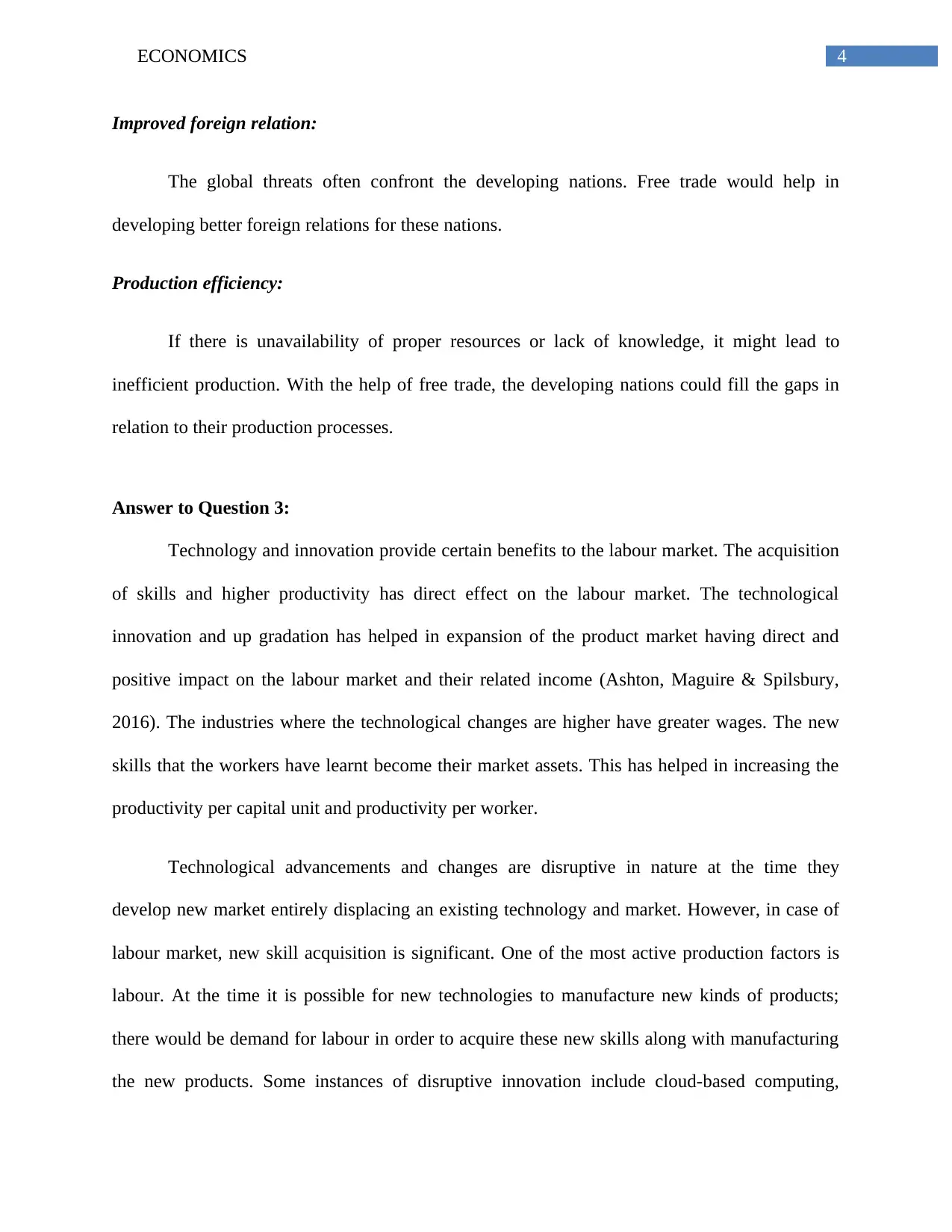
4ECONOMICS
Improved foreign relation:
The global threats often confront the developing nations. Free trade would help in
developing better foreign relations for these nations.
Production efficiency:
If there is unavailability of proper resources or lack of knowledge, it might lead to
inefficient production. With the help of free trade, the developing nations could fill the gaps in
relation to their production processes.
Answer to Question 3:
Technology and innovation provide certain benefits to the labour market. The acquisition
of skills and higher productivity has direct effect on the labour market. The technological
innovation and up gradation has helped in expansion of the product market having direct and
positive impact on the labour market and their related income (Ashton, Maguire & Spilsbury,
2016). The industries where the technological changes are higher have greater wages. The new
skills that the workers have learnt become their market assets. This has helped in increasing the
productivity per capital unit and productivity per worker.
Technological advancements and changes are disruptive in nature at the time they
develop new market entirely displacing an existing technology and market. However, in case of
labour market, new skill acquisition is significant. One of the most active production factors is
labour. At the time it is possible for new technologies to manufacture new kinds of products;
there would be demand for labour in order to acquire these new skills along with manufacturing
the new products. Some instances of disruptive innovation include cloud-based computing,
Improved foreign relation:
The global threats often confront the developing nations. Free trade would help in
developing better foreign relations for these nations.
Production efficiency:
If there is unavailability of proper resources or lack of knowledge, it might lead to
inefficient production. With the help of free trade, the developing nations could fill the gaps in
relation to their production processes.
Answer to Question 3:
Technology and innovation provide certain benefits to the labour market. The acquisition
of skills and higher productivity has direct effect on the labour market. The technological
innovation and up gradation has helped in expansion of the product market having direct and
positive impact on the labour market and their related income (Ashton, Maguire & Spilsbury,
2016). The industries where the technological changes are higher have greater wages. The new
skills that the workers have learnt become their market assets. This has helped in increasing the
productivity per capital unit and productivity per worker.
Technological advancements and changes are disruptive in nature at the time they
develop new market entirely displacing an existing technology and market. However, in case of
labour market, new skill acquisition is significant. One of the most active production factors is
labour. At the time it is possible for new technologies to manufacture new kinds of products;
there would be demand for labour in order to acquire these new skills along with manufacturing
the new products. Some instances of disruptive innovation include cloud-based computing,
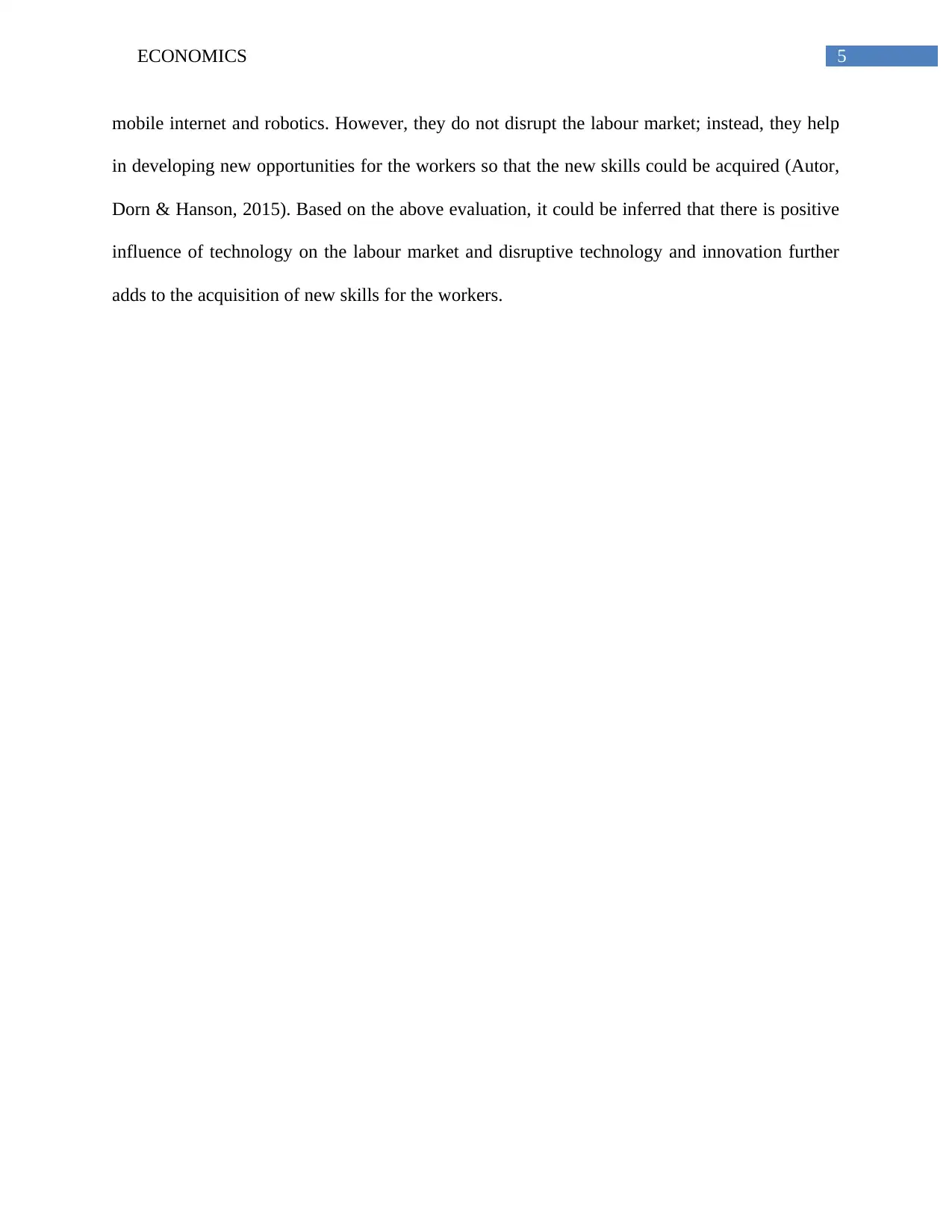
5ECONOMICS
mobile internet and robotics. However, they do not disrupt the labour market; instead, they help
in developing new opportunities for the workers so that the new skills could be acquired (Autor,
Dorn & Hanson, 2015). Based on the above evaluation, it could be inferred that there is positive
influence of technology on the labour market and disruptive technology and innovation further
adds to the acquisition of new skills for the workers.
mobile internet and robotics. However, they do not disrupt the labour market; instead, they help
in developing new opportunities for the workers so that the new skills could be acquired (Autor,
Dorn & Hanson, 2015). Based on the above evaluation, it could be inferred that there is positive
influence of technology on the labour market and disruptive technology and innovation further
adds to the acquisition of new skills for the workers.
⊘ This is a preview!⊘
Do you want full access?
Subscribe today to unlock all pages.

Trusted by 1+ million students worldwide
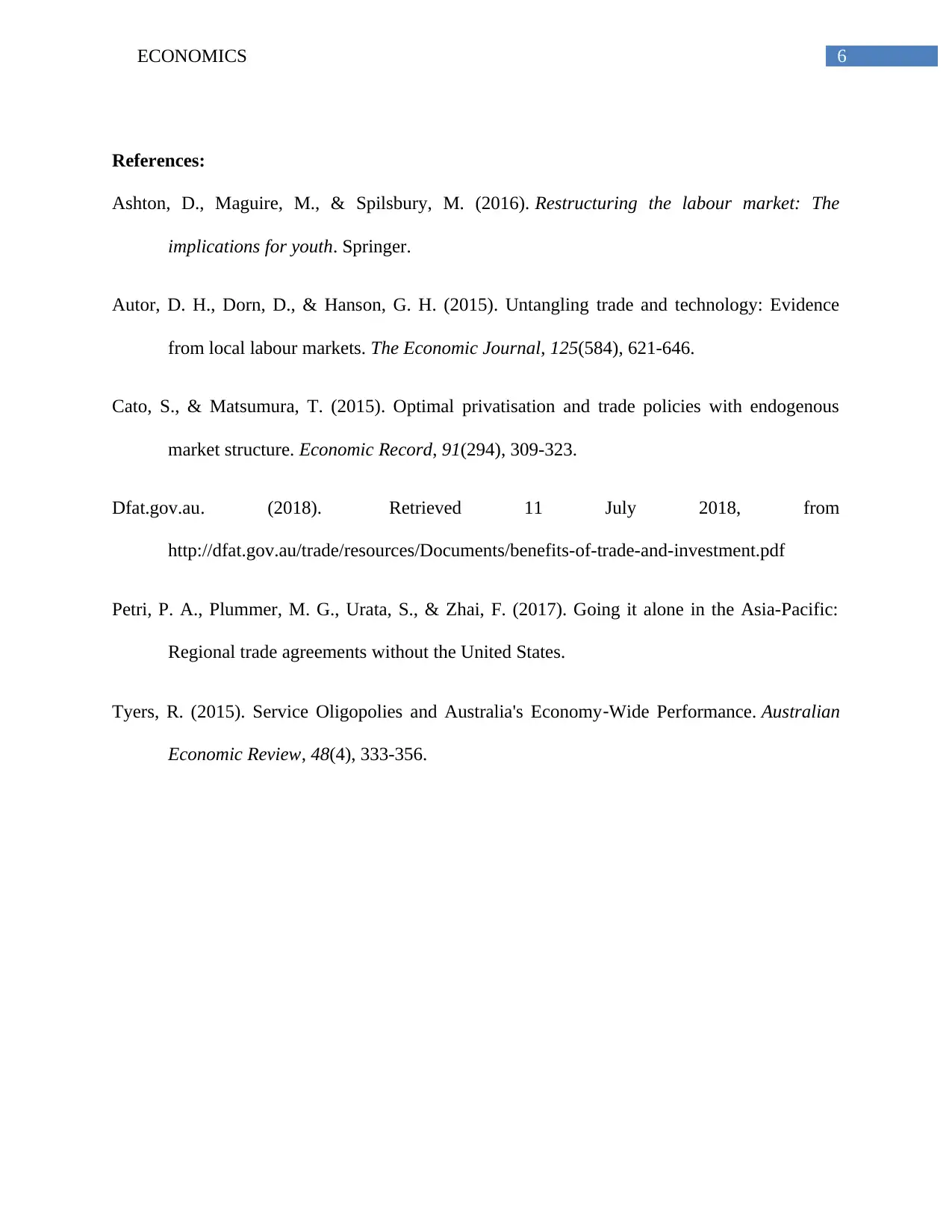
6ECONOMICS
References:
Ashton, D., Maguire, M., & Spilsbury, M. (2016). Restructuring the labour market: The
implications for youth. Springer.
Autor, D. H., Dorn, D., & Hanson, G. H. (2015). Untangling trade and technology: Evidence
from local labour markets. The Economic Journal, 125(584), 621-646.
Cato, S., & Matsumura, T. (2015). Optimal privatisation and trade policies with endogenous
market structure. Economic Record, 91(294), 309-323.
Dfat.gov.au. (2018). Retrieved 11 July 2018, from
http://dfat.gov.au/trade/resources/Documents/benefits-of-trade-and-investment.pdf
Petri, P. A., Plummer, M. G., Urata, S., & Zhai, F. (2017). Going it alone in the Asia-Pacific:
Regional trade agreements without the United States.
Tyers, R. (2015). Service Oligopolies and Australia's Economy‐Wide Performance. Australian
Economic Review, 48(4), 333-356.
References:
Ashton, D., Maguire, M., & Spilsbury, M. (2016). Restructuring the labour market: The
implications for youth. Springer.
Autor, D. H., Dorn, D., & Hanson, G. H. (2015). Untangling trade and technology: Evidence
from local labour markets. The Economic Journal, 125(584), 621-646.
Cato, S., & Matsumura, T. (2015). Optimal privatisation and trade policies with endogenous
market structure. Economic Record, 91(294), 309-323.
Dfat.gov.au. (2018). Retrieved 11 July 2018, from
http://dfat.gov.au/trade/resources/Documents/benefits-of-trade-and-investment.pdf
Petri, P. A., Plummer, M. G., Urata, S., & Zhai, F. (2017). Going it alone in the Asia-Pacific:
Regional trade agreements without the United States.
Tyers, R. (2015). Service Oligopolies and Australia's Economy‐Wide Performance. Australian
Economic Review, 48(4), 333-356.
1 out of 7
Related Documents
Your All-in-One AI-Powered Toolkit for Academic Success.
+13062052269
info@desklib.com
Available 24*7 on WhatsApp / Email
![[object Object]](/_next/static/media/star-bottom.7253800d.svg)
Unlock your academic potential
Copyright © 2020–2025 A2Z Services. All Rights Reserved. Developed and managed by ZUCOL.





